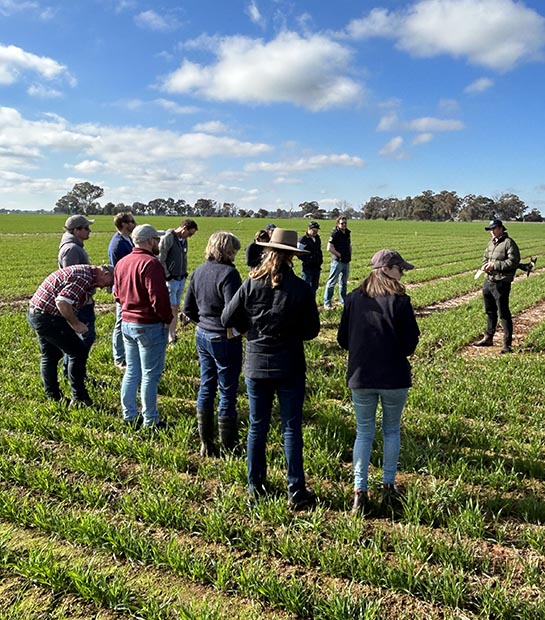This fact sheet supports the presentation by Soil CRC Program Leader Dr Catherine Allan (Charles Sturt University), that discusses designing, delivering and measuring modern, complex extension programs. The presentation is from the Southern NSW Innovation Hub Expanded Horizons Webinar Series for 2023.
Watch the webinar on the Southern NSW Innovation Hub YouTube channel
Evolution of agricultural extension
Agricultural extension has evolved from top-down, linear approaches to more participatory, bottom-up methods. Traditional models focused on transferring innovations from researchers to farmers, while modern approaches involve farmers in the innovation process from the outset. The evolution of extension reflects the changing priorities and challenges in Australian agriculture, from addressing soil conservation issues in the early 20th century to embracing new technologies and approaches for sustainable land management in the 21st century.
Today’s extension landscape is characterised by a broader range of goals beyond productivity, including environmental sustainability, social acceptability, and individual welfare. Additionally, the information landscape has shifted from a deficit to an overload, making it challenging to capture farmers’ attention and navigate complexity.
Reflection on the concept of adoption in agricultural extension
The concept of adoption remains relevant in agricultural extension, but should be viewed as a gateway to foster reflection and reflexivity in project development. While adoption is useful for assessing the uptake of innovations such as technology and tools, it is important to consider the broader context and the interconnectedness of various factors influencing success. Tools like the diffusion of innovation theory curve are still commonly used in extension but are often employed without sufficient context, highlighting the need for a more nuanced understanding of their applicability in modern contexts.
The limitations of exclusive focus on adoption as a measure of success
Exclusive focus on adoption as a measure of success can lead to overlooking valuable learning opportunities and complex responses to changing circumstances. While adoption remains a useful concept, it should be complemented with a broader perspective that considers the context, diverse goals, and the potential for social learning. Relying solely on adoption metrics may result in missing out on understanding why certain innovations are not adopted and the rich insights gained from exploring alternative approaches and adaptations.
The co-constructionist extension approach: embracing complexity for positive change
The co-constructionist extension approach goes beyond linear models of top-down or bottom-up extension, embracing complexity and acknowledging agriculture as a human activity system within broader environmental systems. It emphasises collaboration, co-design, and emergence, trusting that by involving diverse stakeholders in discussions and decision-making processes, meaningful and sustainable change can emerge. Co-constructionist extension encourages active participation, acknowledges multiple sources of knowledge, and fosters dynamic interactions among stakeholders, leading to innovative solutions tailored to specific contexts.
Challenges and opportunities of the co-constructionist approach in extension
The co-constructionist approach in extension presents challenges and opportunities, requiring a shift away from traditional linear models towards more collaborative and emergent processes. While pitching this approach to funders may be challenging within existing funding structures, emphasising longer-term programs, transformative potential, and the need for flexibility can help convey the value of co-design initiatives. Success metrics should focus on transformational outcomes, fostering systemic change rather than just incremental progress, necessitating a re-evaluation of traditional evaluation methods and language.
Promoting the co-constructionist approach through collaborative networks
Encouraging collaboration and finding like-minded practitioners within existing networks can facilitate the adoption of a co-constructionist approach in extension programs. This approach challenges traditional linear models and emphasises reflection on adoption practices, urging practitioners to rethink evaluation methods and language. Leveraging community collectives and longer-term programs, rather than short-term projects, can provide a conducive environment for co-design initiatives, fostering systemic change and aligning with the evolving needs of stakeholders. Embracing a reflective state of mind and openness to complexity are key to implementing co-constructionist principles across diverse agricultural spaces and engaging with stakeholders effectively.
Empowering groups to lead system change
Encouraging reflection on language and assumptions surrounding adoption and diffusion can empower farming systems groups and similar networks to lead systemic change. Leveraging existing relationships within these groups and challenging traditional adoption models can foster collaboration and co-design initiatives, driving positive engagement and change in agricultural practices.

Related Soil CRC projects
- Project 1.2.002 Why soil management practices are adopted
- Project 1.2.008 Packaging Soil CRC tools to enhance extension and adoption of improved soil management practices
- Project 1.4.002 Building farmer innovation capability
- Project 1.4.005 A new tool for assessing the benefits of adopting new farming practices.
Related Soil CRC resources
- Fact sheet: A framework for assessing adoptability to improve soil performance
- Report: Why soil management practices are adopted
- Webinar: Building Farmer Innovation Capability
- Webinar: Farm care networks and adoptability of soil improvement practices
- Webinar: Future Farmers – What drives their decision making?
- Videos: Soil CRC Knowledge Sharing Project extension series
Acknowledgement
This fact sheet was published as part of the ‘Building technical capacity for improved soil management’ project. It was produced by the Soil CRC and jointly funded through the Australian Government’s National Landcare Program.
Posted Apr 18, 2024

